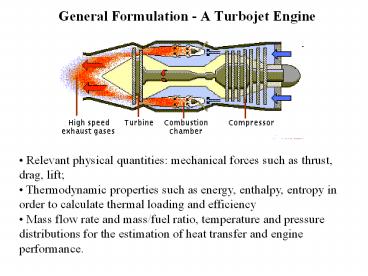General Formulation - A Turbojet Engine - PowerPoint PPT Presentation
Title:
General Formulation - A Turbojet Engine
Description:
Title: System and Control Volume Approach Author: C. Shih Last modified by: Farrukh Alvi Created Date: 2/15/1999 10:10:01 AM Document presentation format – PowerPoint PPT presentation
Number of Views:694
Avg rating:3.0/5.0
Title: General Formulation - A Turbojet Engine
1
General Formulation - A Turbojet Engine
- Relevant physical quantities mechanical forces
such as thrust, drag, lift - Thermodynamic properties such as energy,
enthalpy, entropy in order to calculate thermal
loading and efficiency - Mass flow rate and mass/fuel ratio, temperature
and pressure distributions for the estimation of
heat transfer and engine performance.
2
Governing Equations
Conservation Principles Mass conservation mass
is conserved. (continuity equation) ? 1 scalar
equation Momentum conservation Newtons second
law ? Fma. ? 1 vector equation, or 3 scalar
equations, one in each direction Energy
conservation Second law of Thermodynamics. ? 1
scalar equation. Equation of state Relates
pressure to the density and the temperature
Example the ideal gas law, PrRT ? 1 scalar
equation. Fluid properties to be analyzed
pressure (P), velocity (three components U, V,
W), density(r), temperature (T). Six partial
differential equations for six unknowns, can be
solved if proper boundary and initial conditions
are given
3
Integral vs. Differential Approach
Estimate of the integral (i.e. total) effects
acting on the system by analyzing the interaction
between the fluids and the flow devices. Ex
thrust produced by the jet engine.
Thrust
Governing equations in differential form are
needed to analyze the detials of the flowfiled,
e.g. the flow pattern and its local interaction
with the solid surfaces, the velocity profiles
and shear stress.
Forces (normal and shear stresses) and flow
patterns over individual blades.
4
Defining a System (Closed System vs. Control
Volume)
A closed system must always contain the same
matter. Example A piston between intake and
exhaust strokes. Analysis of fluid properties
based on the system is called Lagrangian approach.
A control volume (also called an Open System)
consists of a volume or an area specified in
space. Matter in a control volume can change
with time as matter enters and leaves its control
surface. Example A jet engine. This type of
analysis is called Eulerian approach.
Extensively used in fluid mechanics for
engineering analysis.
control surface (dotted line)
5
Reynolds Transport Theorem (system ? control
volume)
System (Sys)
Control Volume (CV)
SysCV
Present time (t)
Earlier time
Later time (tDt)
Overlapped (II)
CV
Sys
Mass leaving (III)
Mass entering (I)
6
Mass Conservation
I
CSI (control surface)
7
Mass Conservation
III
CSIII (control surface)
Mass Conservation in control volume form
8
Example
Metal can be cut by using an oxyacetylene torch.
During the process, oxygen is supplied via a
pressurized tank (30 cm in dia. And 1 m tall). A
valve is used to maintain the oxygen flowing out
at a constant velocity of 2 m/s. The valve has
an opening area of 10-4 m2 and the temperature
inside the tank is unchanged and equal to 25C.
If the initial pressure inside the tank is 10,000
kPa gage, how long will it take to drain the tank
such that the pressure is 90 of its initial
value.
2 m/s
9
Example (cont.)
10
More Example
In a rocket engine, liquid fuel and liquid oxygen
are fed into the combustion chamber as shown
below. The hot exhaust gases of the combustion
flow out of the nozzle at high exit velocity of
1000 m/s. Assume the pressure and temperature of
the gases at the nozzle exit are 100 kPa and 800
K, respectively. The nozzle has an exit area of
0.05 m2. Determine the mass flow rate of the
fuel if the oxygen and fuel ratio is set at 5 to
1. Also, assume the exhaust gases can be modeled
as an ideal gas with R1 kJ/kg.K.
Converging-diverging nozzle
oxygen
fuel
Combustion chamber
Shuttle Launch
11
Example (cont.)































